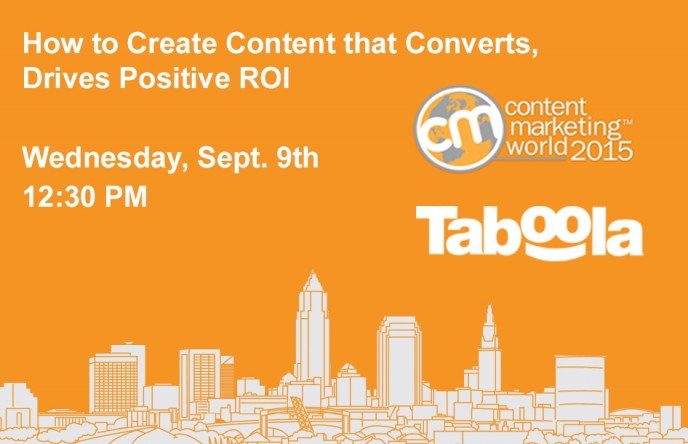Next week, over 3,500 people — spanning marketing and PR professionals, business executives, content managers and creators — will gather in Cleveland, Ohio for Content Marketing World 2015. Hosted by Content Marketing Institute, the four-day event (Sept 8-11) attracts attendees from all industries to share best practices around how companies can use content to drive new business and differentiate their brand amidst a crowded marketplace.
We’re very excited that Taboola was invited to host a “lunch and learn” session on How to Create Content that Converts, Drives Positive ROI. The presentation will include several practical case studies featuring companies that built successful performance-driven content strategies, while also sharing our best practices on topics such as content ideation, landing page optimization, A/B testing, and more.
The session will take place on Wednesday, September 9th at 12:30 PM, presented by Andrew Milk (Director of Media Account Management) and Inbar Yagur (Senior Content Strategist). As a sneak peek into the topics being discussed, we asked Andrew and Inbar to answer a few questions about the state of content marketing today, and where it might be headed in the coming year.
Q: Why haven’t more companies evolved their content marketing strategies to focus on driving conversions?
Many companies start a content marketing initiative without really knowing what to do and how to measure a “return on investment” (ROI). “Content” can also be a daunting concept, seeming nebulous or artistic, and not immediately relevant or connected to marketing goals. But the truth is, content can drive a broad range of conversions (e.g. actions), ranging from a visitor inputting his or her email address, to viewing a product video, to making a purchase. If you can define a desired action, and craft your content around driving towards that action, you are well on your way creating a content campaign that can scale and drive real business.
Q: What is the biggest obstacle for a marketer in transitioning from “brand awareness” campaigns to more performance-driven efforts?
We’re going to cheat and point out two…
The first issue is focusing your goals. As mentioned above, a performance campaign is not always about a sale. On the other hand, you can’t expect all content to be all things. One piece of content can’t drive purchases, and leads, and social shares, and new visitors. It’s about moving from the macro to the micro in your thinking. Once you have a look, an editorial voice, and a big picture in place, you can plan out article-by-article to make sure each piece of content is driving a specific action.
The second issue revolves around reconciling editorial concerns with the “sales” angle of a piece. We often see marketers at odds with blog writers, and there is an underlying perception that a performance-driven content piece can’t have a clear editorial voice. That is very far from true. Not every sales pitch has to be written like a spammy banner ad. There are plenty of ways to blend both interests in an efficient and seamless manner. It’s just a question of communication, and pushing away the misconceptions around performance content in general.
Q: Are there specific businesses or industries where you’ve found performance-driven content to be especially effective?
The truth is that, given the right content strategy, almost anything can work. We’ve seen performance-driven content drive results for everything from personal razor products to real estate. The most prevalent vertical right now may be personal finance, but we’re also seeing a boom in the online retailing space around areas including subscription services, B2B and entertainment.
Q: Has the industry shift toward mobile made performance-driven content easier or harder to promote?
Right now, the mobile shift is a huge challenge that everyone is still trying to figure out. It’s easy to promote performance-driven content on mobile. The problem is that it’s being promoted in a manner that is almost identical to desktop, and that can often be problematic.
When promoting on mobile, we strongly encourage A/B testing several different approaches, both on a campaign level and regarding the post-click user experience. Most importantly, don’t lose sight of who your audience is! Are they a 20-something “mobile-first” internet user who doesn’t own a laptop? Are they a 40-something working professional on a train, commuting to the office? The situation is different, which means the behavior will be different. It’s imperative to adjust your strategy accordingly.
Q: What are the key question(s) your session at CMW will answer?
- How to build a “micro” content strategy to drive per-article conversions
- How to lay out your content on the page in a way that speaks to even the most inattentive user
- How to build out a content piece and a call to action that don’t feel too aggressive, but are also effective
Check out the official CMW 2015 event page to learn more about our panel. And if you’ll be in Cleveland next week for the big event, we look forward to meeting you!
